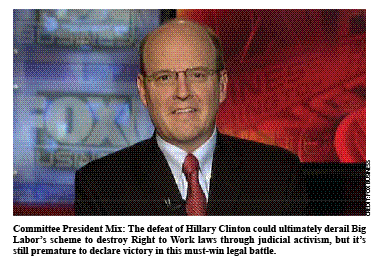Is This Any Way to Run a City’s Schools?
Leaked CTU Proposals Won’t Do Anything to Improve Schools’ Poor Performance
Incoming President’s First High Court Choice Could Be Crucial
 For the third time in just six years, voters in the vast majority of the 50 states dealt a drubbing to union-boss puppet politicians in the 2016 federal elections.
For the third time in just six years, voters in the vast majority of the 50 states dealt a drubbing to union-boss puppet politicians in the 2016 federal elections.
In November 2010, voters were angry, in significant part due to union-boss power grabs such as the “Card Check” Unionization Bill, which would have virtually eliminated secret-ballot voting for union certification and handed Big Labor a huge new weapon to force workers into unions.
As a consequence of the citizen backlash, then-Speaker Nancy Pelosi (D-Calif.) and other union-label politicians were removed from their U.S. House leadership positions.
Four years later, the defeats of five U.S. Senate incumbents who had voted against national Right to Work legislation in 2009 led to the ouster of diehard forced-unionism advocate Harry Reid (D-Nev.)from his perch as majority leader.
Presidential Election Won’t Automatically End Judicial War on Right to Work
And this past fall, the union hierarchy’s White House bastion in Washington, D.C., finally fell prey to the wrath of freedom-loving citizens nationwide.
By a decisive 306-to-232 electoral vote margin, avowed Right to Work supporters Donald Trump and Mike Pence defeated compulsory-unionism cheerleaders Hillary Clinton and Tim Kaine in the 2016 contest to become the next U.S. President and Vice President.
“Regardless of how the Trump presidency turns out, there is no doubt that the Clinton defeat, combined with the union political machine’s failure to recapture operational control over either chamber of Congress, is a serious blow to Big Labor,” said National Right to Work Committee President Mark Mix.
Mr. Mix then cited perhaps the single most important reason why:
Once he takes the oath of office a few weeks after this Newsletter edition goes to press, the next President could potentially use his court appointment powers to put a halt to an ongoing judicial scheme that has threatened to nullify every state law prohibiting forced union dues and fees.
 He cautioned, however, that the presidential election result will by no means automatically derail Big Labor’s campaign to eviscerate all 26 Right to Work laws now on the books through judicial activism, represented by federal cases such as International Union of Operating Engineers Local 370 v. Wasden.
He cautioned, however, that the presidential election result will by no means automatically derail Big Labor’s campaign to eviscerate all 26 Right to Work laws now on the books through judicial activism, represented by federal cases such as International Union of Operating Engineers Local 370 v. Wasden.
IUOE Local 370 and a second pending anti-Right to Work federal lawsuit target workplaces where Big Labor is empowered by law to represent all front-line employees, including union members and nonmembers alike, throughout all negotiations with the employer on key matters concerning terms of employment.
Fifth Anti-Right to Work Justice Could Detonate Judicial ‘Doomsday’ Weapon
According to Big Labor lawyers, union officials in such workplaces have a constitutional right to seize forced fees from nonmembers on pain of termination if they refuse.
In late October, Judge Edward Lodge of the U.S. District Court for the District of Idaho dismissed IUOE Local 370. He correctly pointed out that Big Labor’s judicial attack on Right to Work is in conflict with multiple federal court precedents. But union lawyers are appealing the case.
Mr. Mix commented: “Unfortunately, activist judges do not necessarily pay heed to legal precedents or even simple logic.
“The reason union strategists dared to launch IUOE Local 370 in the fall of 2015 was that they knew that four members of the U.S. Supreme Court — Justices Breyer, Ginsburg, Kagan and Sotomayor — appear to be predisposed to ruling in favor of expanded monopoly privileges for the union hierarchy.
“They calculated that, if just one more reflexively anti-Right to Work justice was appointed before IUOE Local 370 came before the High Court, they could prevail.
“And once Justice Antonin Scalia passed away in February 2016, creating a court vacancy, it seemed union bosses’ audacious judicial assault on Right to Work laws was headed toward success.”
Union Bosses Were Sure They Could Count On Ms. Clinton
Of course, with President Obama’s nomination of union-label federal judge Merrick Garland to fill the Scalia seat permanently stalled in the Senate, the election of Hillary Clinton as President became crucial to Big Labor’s judicial scheme to KO Right to Work laws.
Union officials spent roughly two billion dollars in the 2015-2016 campaign cycle to install Ms. Clinton in the White House and elect other Big Labor puppets to U.S. Senate and House seats and state offices.
Meanwhile, Ms. Clinton was openly vowing that, if she was elected, “organized labor” would “have a champion in the White House.”
For these and other reasons, union bosses’ confidence that a President Clinton would nominate and get confirmed a fifth justice who would join the Breyer-Ginsburg-Kagan-Sotomayor clique on cases concerning Big Labor special privileges was well-founded.
Committee Leader Hopeful President-Elect Trump Will Keep His Campaign Promises
But now that their enormous bet on Ms. Clinton has failed, in large part because, as the exit polls showed, a smaller share of union household members voted for Big Labor’s handpicked presidential candidate than in any election since 1980, what kind of justice can be expected to replace Antonin Scalia?
Mr. Mix recalled that, in February 2016, when he was embroiled in a turbulent contest for the GOP presidential nomination, Mr. Trump heeded the persistent pleas of Committee members and supporters who were then contacting his campaign by pledging he would support Right to Work 100% if elected.
In his completed and signed Committee candidate survey, Mr. Trump pledged, first and foremost, to sign legislation repealing all the provisions in federal labor law that currently authorize and promote the extraction of compulsory union dues and fees from American workers as a job condition.
Moreover, during the final presidential debate on October 19, Mr. Trump pledged that, as the nation’s chief executive, he would appoint Supreme Court justices who “interpret the Constitution the way the founders wanted it interpreted.”
Mr. Mix found significant grounds for hope in this record:
“Based on his avowed support for Right to Work and avowed opposition to creative ‘reinterpetations’ of the Constitution to serve the varied political agendas of our era, I am cautiously optimistic Mr. Trump will not pick High Court or other federal judges who think forced unionism is constitutionally mandated.
“And since there are already four Supreme Court members — Justices Alito, Kennedy, Roberts and Thomas — who have shown themselves to be reluctant to go along with union lawyers’ far-fetched constitutional arguments, the first Trump appointment could, at least for now, ax cases like IUOE Local 370.”
Committee Ready to Fight For Confirmation of Judges With Solid Records
“If Donald Trump follows through on his campaign pledge to select judges who see the meaning of the Constitution and its amendments as fixed at the time of their enactment,” Mr. Mix continued, “then that will be great news for the Right to Work cause.
“Of course, any appointee who resists activist notions like Big Labor lawyers’ contention that the Fifth Amendment’s ‘Takings’ Clause prohibits Right to Work laws will certainly meet with fierce opposition from union-label senators when he or she comes up for confirmation.
“But the National Right to Work Committee and its members stand ready to mobilize public support for High Court and other judicial nominees who have solid records showing that they respect the Constitution and the authority of lawmakers to protect employees from forced unionism.”

Leaked CTU Proposals Won’t Do Anything to Improve Schools’ Poor Performance

Wherever Big Labor wields the power to collect forced union dues, union bosses funnel a large share of the confiscated money into efforts to elect and reelect business-bashing politicians. Employment growth tends to lag as a consequence.

Members Insist They Keep Pro-Right to Work Campaign Promises